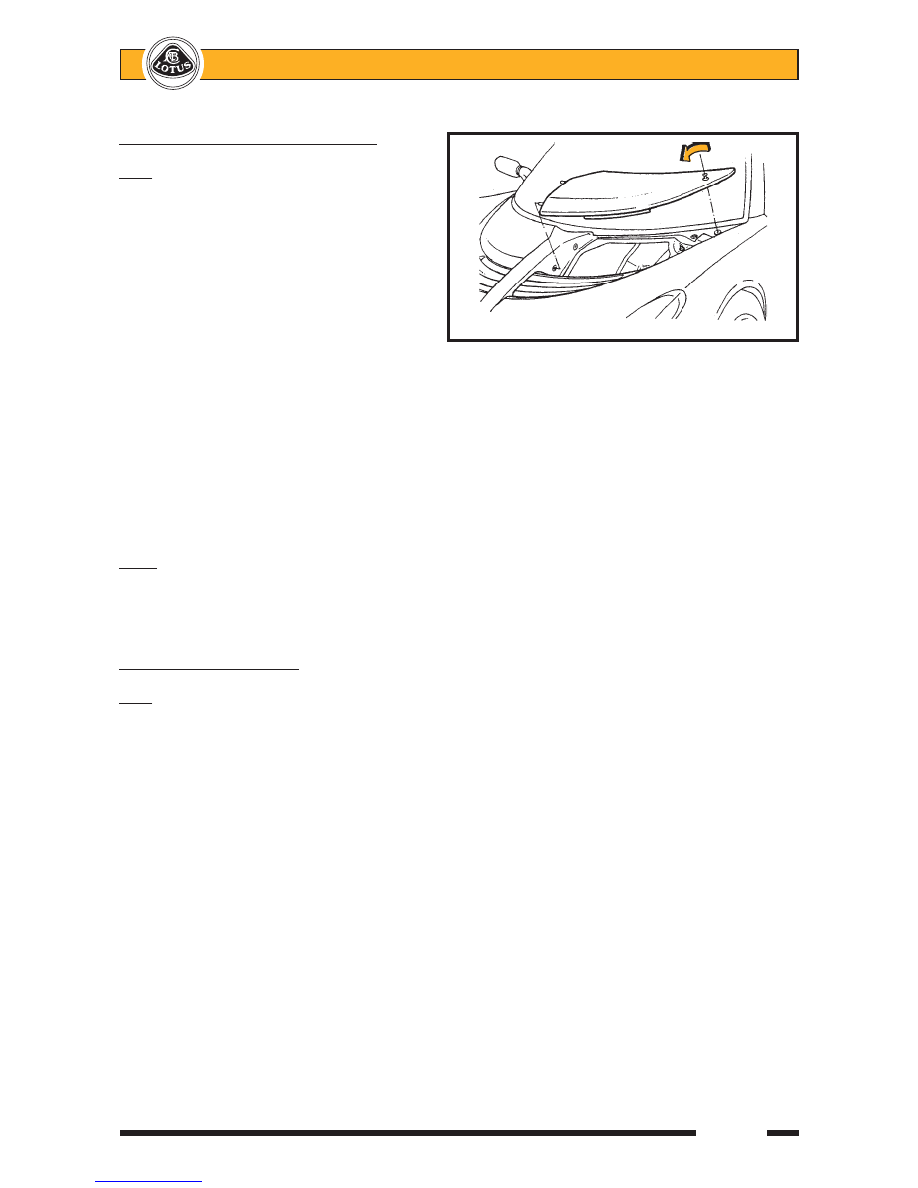Lotus Elise / Lotus Exige. Instruction - part 13

Lotus Service Notes Section BR
Page 7
BR.3 - FRONT BODY ACCESS PANELS
Elise
Two removeable, body colour compos-
ite panels are provided in the front body to
allow access to the front fusebox and brake
fluid reservoir.
To remove an access panel: Use the hexago-
nal key supplied in the vehicle tool kit (in the
battery cover rear pocket), to release the sin-
gle threaded fastener securing the outboard
corner of the panel, and withdraw the panel
from the two locating holes in the front body
spine. Guard against the lightweight panel
being blown away and damaged by a strong
wind.
To refit a panel: Hook the extended lip on the front edge of the panel beneath the rear edge of the louvre panel
before engaging the two locating pegs on the inboard side of the access panel with the grommeted holes in the
front body spine. Fit the single screw at the outboard corner of the panel into the captive nut in the body, taking
care not to cross-thread or overtighten the screw. Re-stow the hexagonal key in the tool kit.
Note that the outboard fastener uses a mounting plinth adjustable in height to allow optimum panel
alignment to be achieved.
WARNING: Ensure the access panels are refitted and properly secured before driving.
Exige
The access panels on the Exige model are shorter front to back than those of the Elise, and are retained
by three socket head screws, the outermost of which features an adjustable plinth to allow panel height adjust-
ment.
BR.4 - ENGINE COVER LID
Elise
The engine cover/boot lid is moulded from glass fibre composite and incorporates 4 engine cooling outlet
grilles secured by double sided tape and plastic rivets into recessed apertures. Two hinges are used to attach
the lid to the rear bulkhead, with stud plates fixing the hinges to the bulkhead from the engine bay side, and the
nuts accessible from the cabin after removal of the rear bulkhead trim panel. A single, key operated latch
mechanism secures the lid to a striker pin mounted on the clamshell engine/boot bulkhead. The latch is
released by inserting the ignition key into the lock and turning clockwise, the lock barrel being connected to the
latch mechanism by a short link rod. When the latch is released, a spring plunger will lift the lid sufficiently to
allow it to be raised fully by hand. Support the lid by inserting the prop provided on the boot bulkhead into the
slotted plate adjacent to the latch mechanism. The spring plunger also operates a micro-switch for the alarm
system, and is protected from exhaust manifold heat by a steel shield.
When closing the lid, fully engage the latch mechanism by pressing down on the cover only immediately
above the latch. Note that the lock mechanism plastic cover plate on the underside of the engine lid, serves
also to channel any water ingress from around the lock into the engine bay. Drain holes are provided in the
gutter surrounding the engine bay, with a collector and drain tube fitted at the rearmost extremity.
On USA models, an fluorescent emergency internal release handle is fitted on the underside of the lid to
facilitate the escape of a trapped child.
To remove the engine cover, release the cover from the two identical hinges. Note that the hinges also
serve to clamp the clamshell front edge to the cabin rear bulkhead.
Beware that the engine cover is locked whenever it is closed, and always requires the use of the ignition
key to release. Owners should be made aware of the importance of having a spare key available in case of
inadvertently locking the keys in the boot.
REMOVING ACCESS PANEL
ohs93